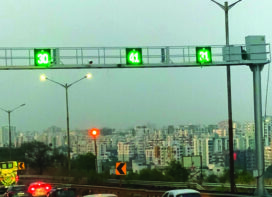 For a comfortable ride in a motorised vehicle two important aspects need to be well constructed. One is the vehicle suspension system which the vehicle manufacturers try to keep improving upon by way of design and testing. While competing with other manufacturers, they strive to make it as economical as possible. In fact the newer generation of vehicles is pronounced in its all round improved performance, starting from engine efficiency and leading to seat comfort and vehicular noise. As regards the suspension system, they are not only competing with each other, but also meeting with a bigger challenge which is the second aspect of a comfortable ride – the road.
For a comfortable ride in a motorised vehicle two important aspects need to be well constructed. One is the vehicle suspension system which the vehicle manufacturers try to keep improving upon by way of design and testing. While competing with other manufacturers, they strive to make it as economical as possible. In fact the newer generation of vehicles is pronounced in its all round improved performance, starting from engine efficiency and leading to seat comfort and vehicular noise. As regards the suspension system, they are not only competing with each other, but also meeting with a bigger challenge which is the second aspect of a comfortable ride – the road.
Roads in Indian cities, especially the metropolitan ones constructed at large budgets, get very quickly dilapidated, often due to water logging. Hence, the clamour for concretisation – which again means higher costs. But then, that too is beset by problems. Of late a via media of concrete paver blocks has been advocated. Are there no problems with these?
A little deeper study of the manner of road construction shows that the technical specifications are often not followed while constructing the roads. Detailed working drawings are not prepared and ad hoc, at-site decisions are taken by site ‘engineers’ who have a vast experience of constructing roads badly. These people, who are to deliver the road ultimately, consider the specifications given in the contract document as theoretical and change them to their level of experience and competence. It cannot be ruled out that this might be done either to save material costs or do away with certain steps which might otherwise incur costs – for some consideration
A point to note is that the so called ‘site engineer’ of the contractor invariably is not even a tenth standard pass. Another point to note is that since no detailed working drawings are done, the drainage aspect does not get addressed correctly and hence, the possibility of water logging increases significantly.
There are problems with existing roads too, which are within the “Defect Liability Period” and beyond and the road users have to face impediments at every nook and corner of the city. Utility services are buried under the roads and footpaths and they get dug up for lack of coordination among the various utility agencies and the municipal corporation. What is appalling is that after the completion of work on the utilities, the reinstatement of roads and footpaths is not done in accordance with the norms laid down.
So how can the problem be tackled and the good condition of roads maintained with minimised portions of unserviceable roads at any given time? It can be done through an Internet Based Road Maintenance and Management System. This is being elaborated in this article, with reference to Municipal Corporation of Greater Mumbai (MCGM), also referred to as Greater Mumbai.
Roads and footpaths (henceforth referred to as roads only) must always be in proper condition throughout the year, and must be safe and comfortable to all sections of road users. While the systems are already in place, the conditions at ground level continue to remain unsatisfactory.
For administrative purposes, Mumbai is divided into 24 wards with each ward further sub divided into several Beat Areas which are the same as the electoral wards, totalling 227 in number. For the entire Greater Mumbai with its 1900km of road network, an average of 8.5km road exists per beat area.
Major roads are taken up for reconstruction, including concretisation, by the Central Agency from the office of Chief Engineer (Roads, Traffic and Bridges) of MCGM. Depending upon where the road’s stretch falls, its reconstruction is handled by the Deputy Chief Engineer (Roads, Traffic and Bridges) of city, western suburbs and eastern suburbs. These reconstructed roads, in their defect liability period (DLP – three years for asphalt/bitumen roads and roads with concrete paver blocks or five years for cement concrete roads), are maintained by the contractor who has carried out the reconstruction. Thereafter, until the road is taken up again for reconstruction, the road is maintained by the ward through its Civil Works Contractor (CWC).
There are many minor roads which are not taken up by the Central Agency of MCGM but are reconstructed by the wards through their CWC. These two are similarly maintained by the concerned CWC until the completion of DLP where after the ward carries out the maintenance through another CWC or department.
Some of the roads fall within the jurisdiction of other governmental agencies such as MMRDA, MSRDC, PWD, MbPT, Aarey Colony, etc. Also, the roads within the private/public layouts do move into the jurisdiction of MCGM after these layouts are developed and then handed over to the MCGM.
 TrafficInfraTech Magazine Linking People Places & Progress
TrafficInfraTech Magazine Linking People Places & Progress


